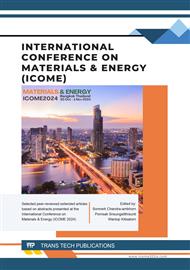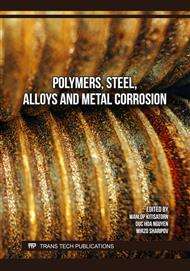[1]
"Annual Global Cost of Corrosion," insights global spec. https://insights.globalspec.com/ article/2340/annual-global-cost-of-corrosion-2-5-trillion
Google Scholar
[2]
"HSE Guideline for Pipeline Operators on Pipeline Anchor Hazards," in A guide to the Pipelines Safety Regulations, Health and Safety Executive, 2009.
Google Scholar
[3]
A. H. Moubaraki and I. B. Obot, "Top of the line corrosion: causes, mechanisms, and mitigation using corrosion inhibitors," 2021.
DOI: 10.1016/j.arabjc.2021.103116
Google Scholar
[4]
P.R. Roberge, "Handbook of Corrosion Engineering," 2nd edition.Washington D.C, 2012, p.1–54.
Google Scholar
[5]
C. J. Han, H. Zhang, and J. Zhang, "Failure pressure analysis of the pipe with inner corrosion defects by FEM," Electrochemical Science, 2016.
DOI: 10.20964/2016.06.6
Google Scholar
[6]
"Top of Line corrosion," Gate.energy, 2016. https://www.gate.energy/the-brainery/gat2004-gkp-2012-10/top-of-line-corrosion
Google Scholar
[7]
M. M. Azzam, "Failure Analysis of Pipelines in the Oil and Gas Industry," Pipeline Engineering, 2022.
Google Scholar
[8]
"Preventing Metal Corrosion," Minnesota Industrial Coatings, 2021. https://minnesotaindustrialcoatings.com/preventing-metal-corrosion/ (accessed Jan. 06, 2023).
Google Scholar
[9]
M. Seiersten, A. Dugstad, J. Nossen, and O. Sendstad, "Top of line corrosion in gas-condensate pipelines," 2021.
DOI: 10.1088/1757-899x/1201/1/012082
Google Scholar
[10]
Camacho A, Singer M, Brown B, and Nesic S, "'Top of the Line Corrosion in H2S/ CO2 Environments,'" in in Proc. Corrosion, Houston, TX, 2018, paper no. 08470, 2008.
Google Scholar
[11]
N. Yaakob, M. Singer, and D. Young, "Top of the Line Corrosion Behavior in Highly Sour Environments: Effect of the Gas/Steel Temperature," in Proc. Corrosion, Houston, TX, 2014, paper no. 3807, Houston], 2014.
Google Scholar
[12]
D. Vedapuri, C. Kang, D. Dhanabalan, and M. Gopal, "Inhibition of Multiphase Wet Gas corrosion," in Proc. Corrosion, paper No. 00043, Athens, 2000.
Google Scholar
[13]
G. Svenningsen, "'Sour Top of Line Corrosion: An Overview,'" Norway, 2015.
Google Scholar
[14]
W. Renpu, Oil and Gas Well Corrosion and Corrosion Prevention, 3rd edition., vol. 11. Elsevier Inc, 2011.
Google Scholar
[15]
K. A. Mohammed, "Ethylated Amine Role in the Inhibition of Top of Line Corrosion in Marginally Sour Environments," Oil and Gas Department, 2022.
DOI: 10.31663/tqujes.12.1.430(2022)
Google Scholar
[16]
Z. B. Wang, L. Pang, and Y. G. Zheng, "A review on under-deposit corrosion of pipelines in oil and gas fields," Corrosion Communications, 2022.
DOI: 10.1016/j.corcom.2022.03.007
Google Scholar
[17]
Y. P. Asmara, "The role of H2S gas in the behaviour of Carbon Steel Corrosion in Oil and Gas Environment," 2018.
Google Scholar
[18]
M. Singer, "Top of the line corrosion-Part 1: Review of the mechanism and laboratory experience," 2014.
Google Scholar
[19]
S. Nesic, Y. Zheng, B. Brown, and J. Ning, "Advancement In Predictive Modeling of Mild Steel Corrosion In CO₂ And H₂S Containing Environments," in in Proc. Corrosion, paper no. 6146, 2015.
DOI: 10.5006/1667
Google Scholar
[20]
Z. Ma, Y. Yang, B. Brown, S. Nesic, and M. Singer, "Investigation of FeCO3 and FeS Precipitation Kinetics by EQCM," in Proc. Corrosion, Houston, TX, 2018, paper no. 11192, 2018.
DOI: 10.1016/j.corsci.2018.06.017
Google Scholar
[21]
Y. Li, R. A. van Santen, and T. Weber, "High-temperature FeS-FeS2 solid-state transitions: Reactions of solid mackinawite with gaseous H2S," Solid State Chemistry, 2008.
DOI: 10.1016/j.jssc.2008.08.024
Google Scholar
[22]
Y. Wang, J. Li, C. Qu, W. Li, M. Baba Pali, and H. Zheng, "Corrosion of Oil and Gas Field Gathering Pipeline in H2S - CO2-Cl-System," IOP Publishing Ltd, 2020.
DOI: 10.1088/1755-1315/555/1/012046
Google Scholar
[23]
N. Yaakob, M. Singer, and D. Young, "Localized Top of the Line Corrosion in Marginally Sour Environments," in Proc. Corrosion, Houston, TX, 2016, paper no. 7695, 2016.
Google Scholar
[24]
M. Singer, "Top Of The Line Corrosion In Sour Environment – Study Of The Controlling Parameters," Athhes, Ohio, 2011.
Google Scholar
[25]
M. Achour, J. Kolts, P. Humble, and R. Hudgins, "Experimental Evaluation Of Corrosion Inhibitor Performance In Presence Of Iron Sulfide In CO2/ H2S Environment," in Proc. Corrosion, paper no. 08344, Houston, TX, 2008.
Google Scholar
[26]
M. Singer, B. Brown, A. Camacho, and S. Nesic, "Combined Effect of Carbon Dioxide, Hydrogen Sulfide, and Acetic Acid on Bottom-of-the-Line Corrosion," 2011.
DOI: 10.5006/1.3543715
Google Scholar
[27]
B. N. Brown, S. Nesic, B. Brown, and S. Reddy Parakala, "CO2 Corrosion in the Presence of Trace Amounts of H2S Localized corrosion of mild steel in slightly sour condition," in in Proc. Corrosion, paper no. 604736, 2014.
Google Scholar
[28]
C. Ren, D. Liu, Z. Bai, and T. Li, "Corrosion behavior of oil tube steel with hydrogen sulfide and carbon dioxide," Mater Chem Phys, vol. 93, no. 2–3, p.305–309, Oct. 2005.
DOI: 10.1016/j.matchemphys.2005.03.010
Google Scholar
[29]
ASTMG1-03, "Standard Practice for Preparing, Cleaning and Evaluating Corrosion Test," Phidelphia, PA. ASTM, Phidelphia, PA, 1999.
Google Scholar
[30]
ASTMG46-94, "Standard Guide for Examination and Evaluation of Pitting Corrosion," ASTM. Phildelpia, PA, 2018.
Google Scholar
[31]
M. A. Islam and Z. N. Farhat, "Characterization of the Corrosion Layer on Pipeline Steel in Sweet Environment," J Mater Eng Perform, vol. 24, no. 8, p.3142–3158, Aug. 2015
DOI: 10.1007/s11665-015-1564-4
Google Scholar



